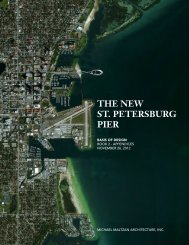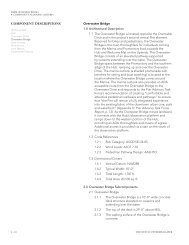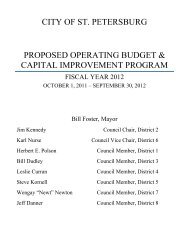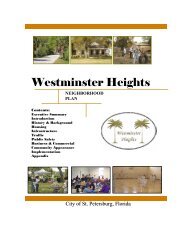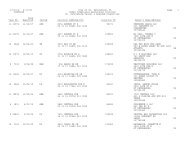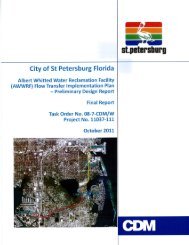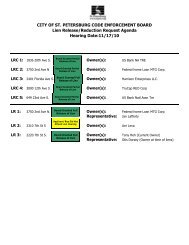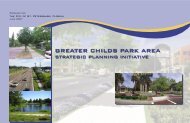Book 1 - City of St. Petersburg
Book 1 - City of St. Petersburg
Book 1 - City of St. Petersburg
You also want an ePaper? Increase the reach of your titles
YUMPU automatically turns print PDFs into web optimized ePapers that Google loves.
BASIS OF DESIGN BOOK 1<br />
3 GENERAL PLANNING CRITERIA<br />
SITE AND URBAN<br />
DESIGN CRITERIA<br />
(continued)<br />
Water Levels<br />
Tides in the Tampa Bay region are mixed semi-diurnal tides,<br />
meaning water levels may exhibit one high and low tide (diurnal)<br />
or two high and two low tides (semi-diurnal) in any given day or<br />
cycle.<br />
Figure 3.26 describes the relationship between the three<br />
different water level datum systems relevant to the new Pier<br />
(NAVD 88, NGVD 29 and the <strong>St</strong>. <strong>Petersburg</strong> Datum) and lists key<br />
water level data for the <strong>St</strong>. <strong>Petersburg</strong> Pier. Tidal information<br />
was obtained from NOAA <strong>St</strong>ation 8726520 located near the <strong>St</strong>.<br />
<strong>Petersburg</strong> Coast Guard station. This data was accumulated over<br />
19 years <strong>of</strong> measurements, from 1983 to 2001.<br />
Sea Level Rise<br />
With sea levels around the world rising, human populations living<br />
in coastal regions and ecosystems in the natural environment<br />
may potentially be impacted. Global average sea level rose at<br />
an average <strong>of</strong> around 1.7 +/- 0.3 mm per year from 1950 to 2009<br />
and at a satellite-measured average rate <strong>of</strong> about 3.3 +/- 0.4<br />
mm per year from 1993 to 2009, an increase on earlier estimates.<br />
Though it is unclear whether the rate reflects an increase in<br />
the underlying long term trend, observed sea level rise has<br />
been taken into consideration in the design <strong>of</strong> the new Pier, in<br />
particular because the project has a 75-year life span.<br />
In response to wave action and sea level rise, the bottom <strong>of</strong> the<br />
lowest structural members are designed to be 1 ft higher than<br />
the base flood elevation. This will place the top surfaces <strong>of</strong> the<br />
new Overwater Drive and Bridge at a level 12 ft above mean sea<br />
level and more than 3 ft above the deck <strong>of</strong> the existing Pier.<br />
Floodplain Management<br />
Preliminary code analysis and floodplain management<br />
considerations are as follows.<br />
Scour at the structure foundation varies depending on the<br />
structure type and dimensions. The depth and design impact <strong>of</strong><br />
scour on the proposed structure should be evaluated for a 100-<br />
year return period event.<br />
<strong>St</strong>orm surge data from the most recent FEMA Flood Insurance<br />
<strong>St</strong>udy (FIS) for Pinellas County (2003) lists the water level at 5.7<br />
ft for a return period <strong>of</strong> 25 years, 7.0 ft for a return period <strong>of</strong> 50<br />
years and 8.3 ft for a return period <strong>of</strong> 100 years.<br />
Figure 3.27 is used to administer the National Flood Insurance<br />
Program for Pinellas County, Florida. An explanation <strong>of</strong> the<br />
design implications for the new Pier, which is subject to extreme<br />
environmental conditions, can be found in the ‘Accessibility and<br />
Code Requirements’ section <strong>of</strong> this Report.<br />
For additional information pertaining to floodplain management<br />
refer to Appendix K: Flood Resistant Design and Construction,<br />
which contains highlights <strong>of</strong> ASCE 24-05, a referenced standard<br />
3 - 48<br />
THE NEW ST. PETERSBURG PIER




